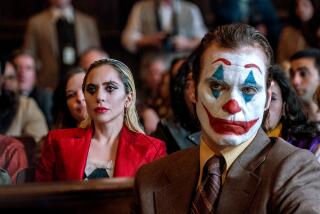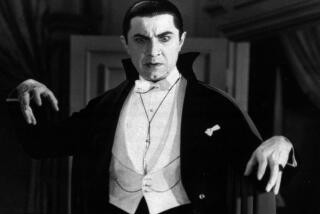TOP-QUALITY HORROR FILMS: A SHOCKING DEVELOPMENT
Perhaps itâs fitting that three of the best, most interesting big-budget American films out now are horror movies (of unusual intensity and gore): James Cameronâs âAliens,â Tobe Hooperâs âThe Texas Chainsaw Massacre 2â and David Cronenbergâs âThe Fly.â
These movies plunge right down into the livid guts of pathology. Theyâre squirmy, crawly, blecchy movies. They rub your nose in death; theyâre full of blood, entrails and the bodyâs topography. Two of them (âAliensâ and âChainsaw 2â) have an almost unprecedented, nonstop graphic violence: chase scenes that go on and on, attacks that seem endless, heroines that are threatened, saved and threatened all over again. The movies may make people jump or even retch. But at least, afterward, they can say theyâve felt something.
Which is more than most current major releases offer you: American movies throughout 1985 and 1986 seem to be taking place in a fancy vacuum, barely connected to the American landscape, to the topical reality thatâs always been the movieâs meat.
Comparatively, âAliens,â âChainsaw 2â and âThe Flyâ seem to be alive--even if their subject matter is an obsession with death. All three wallow in the things that seem wrong with todayâs movies: violence, sensationalism, sex, an over-reliance on the 15- to 25-year-old market (though âChainsawâ is off limits to anyone under 17). And theyâre presold and pretested: Two are sequels and one a remake. In a way, theyâve mastered the current aesthetics of trash, waste, emptiness and bad taste.
And despite their gore, theyâre not as offensive as the run-of-the-muck horror âproduct.â In slasher rip-offs and cutouts, the victims are basically interchangeable: blood-squirting puppets to be dispatched at programmed intervals. (Youâre reminded of âShoah,â of the way the death-camp guards sealed themselves from the reality of mass slaughter by referring to the corpses of gassed inmates not as people but as âragsâ or âdolls.â) In âAliensâ and âChainsawâ--and especially âThe Flyâ--the people count more.
They have something else in common: Thereâs a sympathetic, threatened female at the center. And all three have the germ of a realistic drama, elaborated into a wild nightmare. âAliensâ could be about a wartime woman trying to rescue an abandoned child. âChainsaw IIâ mines the fear of eccentrics, rape and murder. And in âThe Flyâ--the best of the three--Geena Davisâ Veronica could be a professional whose lover is descending into drug addiction or disease. (More than George Langelaanâs story, or Kurt Neumannâs 1958 âFly,â Cronenbergâs film suggests Nicholas Rayâs 1956 âBigger Than Life,â with James Mason as a decent middle-class teacher succumbing to cortisone abuse and paranoia.)
âAliensâ won the most raves of the three, but itâs the lesser achievement. Its story is the most sentimental, straight-ahead and conventional: a little girl, a doll and dozens of last-minute rescues. But itâs the kind of movie many people--especially industry people--feel has to be great. Anything that makes them react so violently, that looks so slick and expensive, has so many obviously classy âelementsâ (James Hornerâs superb pseudo-Bartok score, the eye-popping sets and camera work) must be a triumph.
And it is, though its coups are basically mechanical. This movie--in which Sigourney Weaverâs Ripley returns to the planet of mucoid, parasitic, all-devouring monsters and spends an hour, along with some half-Hawksian macho Marines and a plucky blonde tot, fleeing hell-for-leather through the wreckage--gets away from you too fast. It hooks you, but it doesnât have the resonance of either Ridley Scottâs 1979 film or Cameronâs previous âThe Terminator.â (Perhaps Cameron was trying too hard to âcorrectâ elements he disliked in the big hit he co-wrote, âRambo,â defusing its âsupermanâ militarist mystique.)
Watching âAliensâ is something like being dropped down a greased slide--or in and out of the intestine fun house. Itâs scary and horrific, a mile-a-minute hell drop, but when you shoot out the other end the nightmare is washed clean. Youâre just breathless. (Maybe ready for another ride.) The test of a great movie is not just what happens to you in the theater--but what happens afterward, what youâre left with. Thereâs more stuff sticking to you--the edges of your mind, your emotional ganglia and viscera--after âChainsaw 2â and âThe Fly.â
Writer L. M. Kit Carson and director Hooper have made âChainsaw 2â a grisly hoot: a wild satire on modern Texas and horror movies themselves. Here the maniac family has become rich, mired in marketing and mass franchises. Theyâre fast-food entrepreneurs, blood-stained Ronald McDonalds. (Since their customers and their secret chili ingredient are identical--young Texas yuppies--the whole thing sometimes seems like a drunken nightmare of the James Woods character in âSalvador.â)
This is one sequel that doesnât slavishly copy the first. Hooper gives the images a more outlandish baroque sheen, and the viewpoint is more highly charged and venomous. Thereâs a moral edge to the humor: Itâs beyond the âWe-Market-Bloodâ inside cynicism of the average horror movie. This is a movie about people who market blood, who turn their customers into cannibals. Itâs a deliberately vile joke--but a funny one.
âThe Flyâ goes further. Scenarist Charles Edward Pogue has written unusually rounded, compassionate characterizations--and Cronenberg and the cast deepen them. If âAliensâ is a terrific, glossy shock-machine and âChainsaw 2â is hellishly humorous, âThe Flyâ uses the horror-movie form to get surprising depth, poignancy and feeling.
The key to this movieâs complex, troubling effect may be something in Cronenbergâs character. As a boy, he loved to study insects, and he has said that he finds the anatomical horror effects in his movies--the exploding heads, malign tumors and weird growths in âRabid,â âScannersâ and âVideodromeâ--not nauseating or frightening but beautiful. That perspective gives this monster-portrait a different hue. (So does Jeff Goldblumâs brilliant lead performance.) Cronenberg has a scientistâs perspective, and it seems obvious that, for him, the weird being that Goldblum becomes in the film (the half-man/half-fly or Brundlefly) is not a simple Jekyll-Hyde demon, erupting from inside. Thereâs something eerily impressive in the integration of man and insect. Take the affecting and sad scene where Brundlefly, with melancholy whimsy, tests his powers before his ex-lover: skittering fly-like along the walls and ceiling of his darkened, trash-ridden loft, speculating on flyman-potential.
In a way, Goldblumâs Brundlefly never becomes a complete monster, never loses the essential residue of his humanity. Even at the end, on his bloody rampages, he suggests a werewolf less than he does Quasimodo in âHunchback of Notre Dameâ or the Phantom of the Opera--yearning impossibly for what he can never possess. Brundle, with his insatiable intellectual curiosity, might adjust to his mutated state (the absurdity of being a six-foot-tall Calliphora Vomitra blowfly), except for the tragedy of being physically barred from his lover--a tragedy that eventually consumes him. Because of this, âThe Flyâsâ climax may be too brutal, too peremptory; the movie needs a coda to wind down properly.
You have the sense--in all three of these pop shockers--of an intelligence at work, of someone trying to dig out from under the commercialized savagery and retrieve something genuine, moving, contradictory. Itâs depressing that American movies try so rarely to reflect the realities of American life (a vast, fertile ground being virtually ignored), but at least a few of the movie nightmares are drawing real blood.
More to Read
Only good movies
Get the Indie Focus newsletter, Mark Olsen's weekly guide to the world of cinema.
You may occasionally receive promotional content from the Los Angeles Times.










